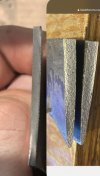CDHumiston
Gold Member
- Joined
- Feb 17, 2009
- Messages
- 1,464
I finally got a small forge and a quench tank. I have some old discarded 1095 blades so I wanted to perform a test. I brought the forge up to around 1800 degrees and the blade was a little brighter than I thought it should be. I came down to 1500 and got a color I liked, checked for nonmagnetic and quenched in room temp canola oil.
Then I let it sit overnight. This morning I put it in a vise for destructive testing. Here are some pictures and a link to the video of me breaking the blade.
I was hoping to anneal the blade and test again, but it broke more than just the tip off...
I would like opinions on the grain structure if possible.


Then I let it sit overnight. This morning I put it in a vise for destructive testing. Here are some pictures and a link to the video of me breaking the blade.
I was hoping to anneal the blade and test again, but it broke more than just the tip off...
I would like opinions on the grain structure if possible.





